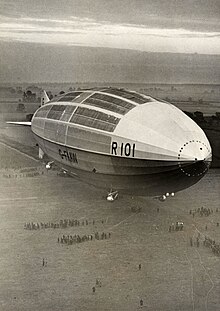| R101 | |
|---|---|
 R101 on the day of its first flight, 14 October 1929 | |
| General information | |
| Role | Experimental airship |
| Manufacturer | Royal Airship Works |
| Designer | |
| Number built | 1 |
| Registration | G-FAAW |
| History | |
| First flight | 14 October 1929[1] |
| Last flight | 4 October 1930[2] |
| Fate | Crashed and burnt out 5 October 1930 |
R101 was one of a pair of British rigid airships completed in 1929 as part of the Imperial Airship Scheme, a British government programme to develop civil airships capable of service on long-distance routes within the British Empire. It was designed and built by an Air Ministry–appointed team and was effectively in competition with the government-funded but privately designed and built R100. When built, it was the world's largest flying craft[3] at 731 ft (223 m) in length, and it was not surpassed by another hydrogen-filled rigid airship until the LZ 129 Hindenburg was launched seven years later.
After trial flights and subsequent modifications to increase lifting capacity, which included lengthening the ship by 46 ft (14 m) to add another gasbag,[4] the R101 crashed in France during its maiden overseas voyage on 5 October 1930, killing 48 of the 54 people on board.[5] Among the passengers killed were Lord Thomson, the Air Minister who had initiated the programme, senior government officials, and almost all the dirigible's designers from the Royal Airship Works.
The crash of R101 effectively ended British airship development, and was one of the worst airship accidents of the 1930s. The loss of 48 lives was more than the 36 killed in the much better-known Hindenburg disaster of 1937, though fewer than the 52 killed in the French military Dixmude in 1923 and the 73 killed when the USS Akron crashed in the Atlantic Ocean off the coast of New Jersey in 1933.
- ^ Shute 1954, p. 77.
- ^ "R101 Passenger List." Airship Heritage Trust via Airshipsonline. Retrieved: 27 August 2010.
- ^ Popular Science Monthly: Keeping Pace with Aviation. Bonnier Corporation. 1930. p. 41.
- ^ "R101". Airship Heritage Trust via Airshipsonline.com. Retrieved: 23 July 2008.
- ^ Report of the R101 Inquiry 1931, p. 7.